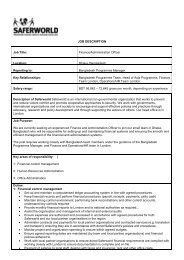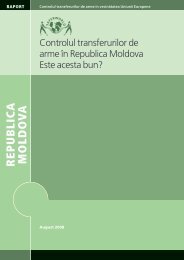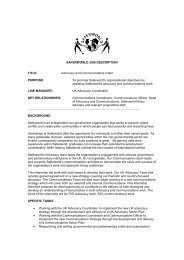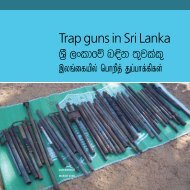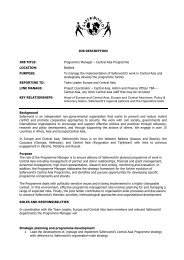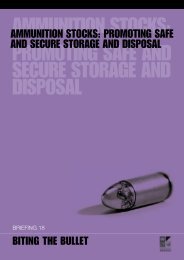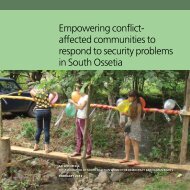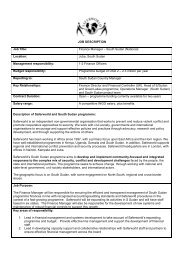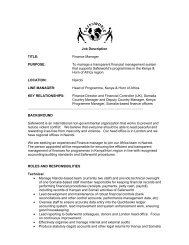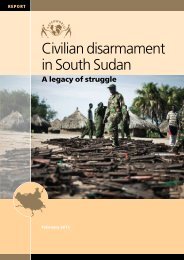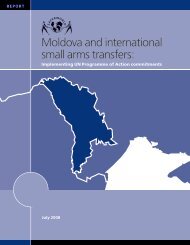Controlling small arms and light weapons in Kenya and ... - Saferworld
Controlling small arms and light weapons in Kenya and ... - Saferworld
Controlling small arms and light weapons in Kenya and ... - Saferworld
You also want an ePaper? Increase the reach of your titles
YUMPU automatically turns print PDFs into web optimized ePapers that Google loves.
<strong>Controll<strong>in</strong>g</strong> <strong>small</strong> <strong>arms</strong> <strong>and</strong><strong>light</strong> <strong>weapons</strong> <strong>in</strong> <strong>Kenya</strong> <strong>and</strong> Ug<strong>and</strong>aProgress so farSAFERWORLDMAY 2011
AcknowledgementsThis paper was researched <strong>and</strong> written by James Ndung’u <strong>and</strong> Manasseh Wepundiwith contributions from Richard Nabudere. Thanks also go to <strong>Saferworld</strong>’s <strong>Kenya</strong> teamfor their additional editorial <strong>and</strong> advisory support, to Hesta Groenewald for overallco-ord<strong>in</strong>ation of this research, to officials <strong>and</strong> stakeholders <strong>in</strong> the countries selectedas case studies for their feedback <strong>and</strong> analysis <strong>and</strong> to the <strong>Kenya</strong> <strong>and</strong> Ug<strong>and</strong>a NationalFocal Po<strong>in</strong>ts.This paper was made possible by fund<strong>in</strong>g from the Governments of the Netherl<strong>and</strong>s,the United K<strong>in</strong>gdom <strong>and</strong> Sweden.© <strong>Saferworld</strong> May 2011. All rights reserved. No part of this publication may bereproduced, stored <strong>in</strong> a retrieval system or transmitted <strong>in</strong> any form or by any meanselectronic, mechanical, photocopy<strong>in</strong>g, record<strong>in</strong>g or otherwise, without full attribution.<strong>Saferworld</strong> welcomes <strong>and</strong> encourages the utilisation <strong>and</strong> dissem<strong>in</strong>ation of the material<strong>in</strong>cluded <strong>in</strong> this publication.
ContentsAcronyms1. Introduction 12. Orig<strong>in</strong>s <strong>and</strong> m<strong>and</strong>ate of SALW control structures 23. The Regional Centre on Small Arms 4RESCA’s strategy 5Progress towards strategy implementation 6Progress to date 74. National Focal Po<strong>in</strong>ts 8The <strong>Kenya</strong> National Focal Po<strong>in</strong>t 8Ug<strong>and</strong>a National Focal Po<strong>in</strong>t on Small Arms <strong>and</strong> Light Weapons 115. Conclusions 156. Recommendations 18References 19
AcronymsDTFKIDDPKNFPNAPNFPPTFRECSARTFSALWSASUNFPUNPOAUPDFDistrict Task Force on SALWKaramoja Integrated Disarmament <strong>and</strong> Development Programme<strong>Kenya</strong> National Focal Po<strong>in</strong>t on SALWNational Action Plan (for SALW Management <strong>and</strong> Control)National Focal Po<strong>in</strong>t on SALWProv<strong>in</strong>cial Task Force on SALWRegional Centre on Small ArmsRegional Task Force on SALW<strong>small</strong> <strong>arms</strong> <strong>and</strong> <strong>light</strong> <strong>weapons</strong>Small Arms SurveyUg<strong>and</strong>a National Focal Po<strong>in</strong>t on SALWUnited Nations Programme of ActionUg<strong>and</strong>a People’s Defence Force
1Introductiona c c o r d i n g t o n a t i o n a l r e p o r t s submitted to the United Nations Office forDisarmament Affairs, as of 2005 at least 89 countries worldwide had establishedNational Commissions for the control of <strong>small</strong> <strong>arms</strong> <strong>and</strong> <strong>light</strong> <strong>weapons</strong> (SALW),while 133 countries had nom<strong>in</strong>ated a National Po<strong>in</strong>t of Contact. 1 While the overallnumber of commissions already established appears encourag<strong>in</strong>g, the m<strong>and</strong>ate <strong>and</strong>effectiveness of these <strong>in</strong>stitutions may vary significantly from one country to another. 2The establishment of effective co-ord<strong>in</strong>ation bodies is a crucial first step towards thedevelopment <strong>and</strong> implementation of national SALW control strategies that effectivelyaddress <strong>small</strong> <strong>arms</strong> proliferation. 3This work<strong>in</strong>g paper is written aga<strong>in</strong>st a background of cont<strong>in</strong>ued formation of nationalco-ord<strong>in</strong>ation mechanisms for the control of SALW globally <strong>and</strong> the persistentquestion as to whether exist<strong>in</strong>g <strong>and</strong> emerg<strong>in</strong>g structures are liv<strong>in</strong>g up to expectations.It assesses the achievements <strong>and</strong> challenges faced by two such structures, namely theNational Focal Po<strong>in</strong>ts for SALW (NFPs) control <strong>in</strong> <strong>Kenya</strong> <strong>and</strong> Ug<strong>and</strong>a, while alsoexam<strong>in</strong><strong>in</strong>g the record of a support<strong>in</strong>g regional body, the Regional Centre on SmallArms (RECSA). Prelim<strong>in</strong>ary conclusions <strong>and</strong> recommendations are drawn at theend of the paper target<strong>in</strong>g RECSA, the two governments <strong>and</strong> also external actors likedonors <strong>and</strong> civil society. A comb<strong>in</strong>ation of desk research <strong>and</strong> selected <strong>in</strong>terviews withNFP staff <strong>and</strong> external stakeholders <strong>in</strong>formed the research.<strong>Kenya</strong> <strong>and</strong> Ug<strong>and</strong>a have been selected for analysis because they were among the firstcountries <strong>in</strong> the East African region to establish co-ord<strong>in</strong>ation bodies follow<strong>in</strong>g agreementof the Nairobi Declaration on the Problem of the Proliferation of the Illicit SmallArms <strong>and</strong> Light Weapons <strong>in</strong> the Great Lakes Region <strong>and</strong> Horn of Africa (the ‘NairobiDeclaration’) <strong>in</strong> the year 2000 <strong>and</strong> as such have had sufficient time to demonstrateboth successes <strong>and</strong> fail<strong>in</strong>gs. The paper does not claim to be a comprehensive study onthe effectiveness of NFPs <strong>in</strong> the region as this would require more substantial research<strong>and</strong> many more case studies. It does however provide an overview of the issues affect<strong>in</strong>gSALW control efforts <strong>in</strong> the region which can be built on <strong>in</strong> subsequent research.1 Kytömäki E <strong>and</strong> Yankey-Wayne V, Five Years of Implement<strong>in</strong>g the United Nations Programme of Action on Small Arms <strong>and</strong>Light Weapons: Regional Analysis of National Reports, (United Nations Institute for Disarmament Research, Geneva, 2006),www.unidir.org/pdf/ouvrages/pdf-resume92-9045-181-5-en.pdf, 13 April 2011.2 United Nations Development Programme, How to Guide The Establishment <strong>and</strong> Function<strong>in</strong>g of National Small Arms <strong>and</strong>Light Weapons Commissions, (Geneva: Bureau for Crisis Prevention <strong>and</strong> Recovery, 2008).3 South Eastern <strong>and</strong> Eastern Europe Clear<strong>in</strong>g House for the Control of SALW, Guide to RMDS/G, 1.10 4th Edition (SEESAC,2006b), www.seesac.org/resources/RMDS%2001.10%20%20Guide%20to%20RMDS%20(Edition%204).pdf,13 April 2011.
2Orig<strong>in</strong>s <strong>and</strong> m<strong>and</strong>ate ofSALW control structuresp r i o r t o t h e e s t a b l i s h m e n t o f s a l w s t r u c t u r e s <strong>in</strong> East Africa likeRECSA <strong>and</strong> the <strong>Kenya</strong> <strong>and</strong> Ug<strong>and</strong>a NFPs, SALW <strong>in</strong>itiatives were largely under thedockets of foreign affairs m<strong>in</strong>istries <strong>and</strong> law enforcement agencies at regional <strong>and</strong>national levels. At the regional level, the Eastern Africa Police Chiefs CooperationOrganisation 4 founded <strong>in</strong> 1998 <strong>and</strong> the Inter-Governmental Authority on Developmentwere particularly active <strong>in</strong> peace <strong>and</strong> security issues.The establishment of the various SALW control structures can therefore be seen asan offshoot of various <strong>in</strong>ternational <strong>and</strong> regional <strong>in</strong>itiatives that emerged around theworld <strong>in</strong> the late 1990s as the lethality of SALW became more appreciated. SALWproliferation was <strong>in</strong>itially given attention by the United Nations through the SecretaryGeneral’s 1995 Agenda for Peace, with a focus on ‘micro-disarmament’. Subsequently,SALW <strong>in</strong>itiatives were <strong>in</strong>itiated by the United Nations, <strong>in</strong>dividual governments,regional <strong>and</strong> sub-regional organisations <strong>and</strong> non-governmental organisations. InAfrica, an African Union heads of government meet<strong>in</strong>g adopted a decision concern<strong>in</strong>gco-operation <strong>in</strong> the search for solutions to the problems posed by the proliferation ofSALW <strong>in</strong> Africa. At the African Union Assembly of Heads of State <strong>and</strong> Governmentsheld <strong>in</strong> Algiers, from 12–14 July 1999, the Summit endorsed the hold<strong>in</strong>g of aCont<strong>in</strong>ental Conference of African Experts on Small Arms <strong>in</strong> 2000. The sign<strong>in</strong>g ofthe Nairobi Declaration on 15 March 2000 was followed n<strong>in</strong>e months later by that ofthe Bamako Declaration on an African Common Position on the Illicit Proliferation,Circulation <strong>and</strong> Traffick<strong>in</strong>g of Small Arms <strong>and</strong> Light Weapons (‘Bamako Declaration’).The Bamako conference (<strong>and</strong> Declaration) <strong>in</strong> 2000 developed an African CommonPosition on the Illicit Proliferation, Circulation <strong>and</strong> Traffick<strong>in</strong>g of SALW <strong>in</strong> preparationfor the UN Conference on the Illicit Trade <strong>in</strong> SALW <strong>in</strong> All its Aspects from 9–20 July2001 <strong>in</strong> New York.The above <strong>in</strong>itiatives all underscore the importance of establish<strong>in</strong>g regional <strong>and</strong>national bodies to co-ord<strong>in</strong>ate action aga<strong>in</strong>st illicit SALW proliferation 5 <strong>and</strong> providethe m<strong>and</strong>ate for NFPs. They <strong>in</strong>clude the United Nations Programme of Action(UNPOA) 6 , the Nairobi Declaration, the Nairobi Protocol 7 <strong>and</strong> the Bamako4 East Africa Police Chiefs Cooperation Organisation’s m<strong>and</strong>ate of jo<strong>in</strong><strong>in</strong>g police efforts aga<strong>in</strong>st trans-national <strong>and</strong> organisedcrime, qualifies it to address SALW-related security concerns.5 Recently, the UN has embarked on develop<strong>in</strong>g International St<strong>and</strong>ards for SALW Control (ISACs), which <strong>in</strong>clude st<strong>and</strong>ardsrelated to national co-ord<strong>in</strong>at<strong>in</strong>g mechanisms on SALW control. However, the various UN ISACs are work <strong>in</strong> progress <strong>and</strong> donot yet constitute UN <strong>in</strong>ternational st<strong>and</strong>ards on SALW control.6 United Nations Programme of Action to Prevent, Combat <strong>and</strong> Eradicate the Illicit Trade <strong>in</strong> SALW of July 2001.7 Nairobi Protocol for the Prevention, Control <strong>and</strong> Reduction of SALW <strong>in</strong> the Great Lakes Region, Horn of Africa <strong>and</strong> theBorder<strong>in</strong>g States signed <strong>in</strong> April 2004 <strong>and</strong> entered <strong>in</strong>to force, follow<strong>in</strong>g ratification by two-thirds of its signatories, <strong>in</strong> May 2006.
s a f e r w o r l d · w o r k i n g p a p e r 3Declaration 8 . The Nairobi Declaration <strong>in</strong> turn urges member states to support subregionalco-operation among police, <strong>in</strong>telligence, customs <strong>and</strong> border control officials<strong>in</strong> combat<strong>in</strong>g the illicit circulation <strong>and</strong> traffick<strong>in</strong>g <strong>in</strong> SALW <strong>and</strong> suppress<strong>in</strong>g crim<strong>in</strong>alactivities related to the use of <strong>weapons</strong>.Bound by the Nairobi Declaration, the signatories agreed <strong>in</strong> 2001 to the Coord<strong>in</strong>atedAgenda for Action <strong>and</strong> an Implementation Plan. NFPs are m<strong>and</strong>ated to monitor theratification, implementation, execution <strong>and</strong> evaluation of the Nairobi Protocol at thenational level <strong>in</strong> liaison with law enforcement agencies. They are also to ensureadherence to the st<strong>and</strong>ards set out <strong>in</strong> the document <strong>and</strong> <strong>in</strong>form the RECSA Secretariaton a regular basis of progress made. This m<strong>and</strong>ate was reaffirmed dur<strong>in</strong>g the 2ndRECSA M<strong>in</strong>isterial Review Conference of 2004 <strong>and</strong> cont<strong>in</strong>ues to guide action onSALW by NFPs at national level.Under the UNPOA every country has committed itself to establish or designatenational co-ord<strong>in</strong>ation agencies or bodies <strong>and</strong> <strong>in</strong>stitutional <strong>in</strong>frastructure responsiblefor policy guidance, research <strong>and</strong> monitor<strong>in</strong>g of efforts to prevent, combat <strong>and</strong> eradicatethe illicit trade <strong>in</strong> SALW <strong>in</strong> all its aspects. States are also committed to establish ordesignate a po<strong>in</strong>t of contact with<strong>in</strong> sub-regional <strong>and</strong> regional organisations to liaise onmatters relat<strong>in</strong>g to the implementation of the Programme of Action. Article 4(d) of theNairobi Protocol requires member states to establish or enhance <strong>in</strong>ter-agency groups,<strong>in</strong>volv<strong>in</strong>g police, military, customs, home affairs <strong>and</strong> other relevant bodies, to improvepolicy co-ord<strong>in</strong>ation, <strong>in</strong>formation shar<strong>in</strong>g <strong>and</strong> analysis at national level. This provisionis reiterated <strong>in</strong> the Bamako Declaration, which was largely <strong>in</strong>fluenced by the NairobiProtocol.8 Bamako Declaration on an African Common Position on the Illicit Proliferation, Circulation <strong>and</strong> Traffick<strong>in</strong>g of SALW of1 December 2000.
3The Regional Centre onSmall Armst h e r e g i o n a l c e n t r e o n s m a l l a r m s (r e c s a ) started as the NairobiSecretariat on SALW follow<strong>in</strong>g the Nairobi Declaration <strong>in</strong> 2000. Member states 9designated the Government of <strong>Kenya</strong> to co-ord<strong>in</strong>ate follow-up to the Declaration,the result of which was the sett<strong>in</strong>g up of the Nairobi Secretariat <strong>in</strong> 2002, located with<strong>in</strong><strong>Kenya</strong>’s M<strong>in</strong>istry of Foreign Affairs. 10The Nairobi Secretariat was moved from the m<strong>in</strong>istry to an <strong>in</strong>dependent office <strong>in</strong> 2003.In June 2005, member states established RECSA under Article 2 of the AgreementEstablish<strong>in</strong>g the Regional Centre on Small Arms <strong>in</strong> the Great Lakes Region, the Hornof Africa <strong>and</strong> Border<strong>in</strong>g States. 11 On 23 October 2006, RECSA <strong>and</strong> the Governmentof <strong>Kenya</strong> signed a Host Agreement. The new-found <strong>in</strong>dependence of RECSA wassignificant <strong>in</strong> several ways. First, the secretariat achieved autonomy by be<strong>in</strong>g freedfrom the government bureaucracy of any one host country – for <strong>in</strong>stance, the officecould operate its own accounts separate from the national treasury. Second, thesecretariat ga<strong>in</strong>ed a truly regional outlook by ceas<strong>in</strong>g to exist as a unit with<strong>in</strong> a (host)member state’s m<strong>in</strong>istry <strong>and</strong> by adopt<strong>in</strong>g a name reflect<strong>in</strong>g its status: the RegionalCentre on Small Arms. RECSA also now enjoys diplomatic status <strong>and</strong> obta<strong>in</strong>edobserver status at the UN General Assembly <strong>in</strong> December 2007. 12RECSA has three organs, namely: the Council of M<strong>in</strong>isters, the Technical AdvisoryCommittee <strong>and</strong> the Secretariat. The Secretariat derives its m<strong>and</strong>ate from Article 18of the Nairobi Protocol. It is responsible for develop<strong>in</strong>g <strong>and</strong> issu<strong>in</strong>g implementationguidel<strong>in</strong>es <strong>and</strong> <strong>in</strong>structions, monitor<strong>in</strong>g implementation <strong>and</strong> evaluat<strong>in</strong>g the NairobiProtocol <strong>in</strong> liaison with law enforcement agencies. The Secretariat is also responsiblefor co-ord<strong>in</strong>at<strong>in</strong>g the jo<strong>in</strong>t effort by NFPs <strong>in</strong> member states to prevent, combat <strong>and</strong>eradicate illicit traffick<strong>in</strong>g <strong>and</strong> build-up of uncontrolled SALW, ammunition <strong>and</strong>related material <strong>in</strong> the Great Lakes <strong>and</strong> Horn of Africa.Table 1 below shows some areas of co-operation between RECSA <strong>and</strong> key regional<strong>and</strong> <strong>in</strong>ternational partner organisations.9 Burundi, Democratic Republic of Congo, Djibouti, Ethiopia, Eritrea, <strong>Kenya</strong>, Rw<strong>and</strong>a, Sudan, Tanzania <strong>and</strong> Ug<strong>and</strong>a.10 RECSA, Nairobi Secretariat Information Tool Kit 2002–2004.11 Member states signed this agreement dur<strong>in</strong>g the Third M<strong>in</strong>isterial Review Conference held <strong>in</strong> Nairobi on 20–21 June, 2005.12 RECSA, Annual Review Report, July 2007–June 2008.
s a f e r w o r l d · w o r k i n g p a p e r 5Table 1: RECSA’s collaboration with partnersPartnerAfrican UnionEuropean UnionEast African CommunityInternational Conference on theGreat Lakes RegionInter-Governmental Authority onDevelopmentCommon Market for Eastern <strong>and</strong>Southern AfricaUnited Nations Centre for Peace<strong>and</strong> Disarmament <strong>in</strong> AfricaUnited Nations DevelopmentProgramme – Bureau for CrisisPrevention <strong>and</strong> Recovery<strong>Saferworld</strong>Institute of Security StudiesSmall Arms SurveyM<strong>in</strong>es Advisory GroupEast Africa Action Network on SALWArea of co-operationEstablishment of a Cont<strong>in</strong>ental SALW Steer<strong>in</strong>g CommitteeCont<strong>in</strong>ental SALW control programme <strong>in</strong> AfricaArms mark<strong>in</strong>g, public awareness, research <strong>and</strong> capacitybuild<strong>in</strong>g.RECSA m<strong>and</strong>ated to implement the SALW project, add<strong>in</strong>gfour other states that are not members of RECSA, namely:Angola, Zambia, Central African Republic <strong>and</strong> Republic ofCongoCo-operat<strong>in</strong>g <strong>in</strong> disarmament projectsAdopted the Nairobi Protocol to guide issues of SALWBrokers <strong>and</strong> dealers electronic softwareNational action plan development, capacity-build<strong>in</strong>g <strong>and</strong>public awareness.Research on harmonisation of fire<strong>arms</strong> laws, capacitybuild<strong>in</strong>gResearch, capacity-build<strong>in</strong>gResearch, capacity-build<strong>in</strong>gStockpile managementCivil society mobilisationSource: RECSA 2009 13RECSA’s broad base of partnership is based on the spirit <strong>and</strong> letter of both the NairobiDeclaration <strong>and</strong> Nairobi Protocol, which underscore the necessity of <strong>in</strong>formationshar<strong>in</strong>g <strong>and</strong> cooperation between governments, <strong>in</strong>ter-governmental organisations <strong>and</strong>civil society. 14RECSA’sstrategyThe Coord<strong>in</strong>ated Agenda for Action <strong>and</strong> its Implementation Plan, established underthe Nairobi Declaration, are the broader frameworks that guide implementation ofSALW action by RECSA. In practice though, RECSA has implemented its activitiesbased on periodic strategic plans <strong>and</strong> implementation strategies. The current implementationstrategy runs from 2009–2014 <strong>and</strong> sets the various milestones that NFPsshould achieve dur<strong>in</strong>g this period. The milestones high<strong>light</strong>ed <strong>in</strong> this strategy lie <strong>in</strong>three ma<strong>in</strong> thematic areas, namely: strengthen<strong>in</strong>g of <strong>in</strong>stitutions, effective <strong>in</strong>formationprovision <strong>and</strong> promotion <strong>and</strong> facilitation of SALW management. 1513 Wairagu F, ‘Progress <strong>in</strong> the Implementation of the Nairobi Protocol’, paper presented dur<strong>in</strong>g RECSA’s Implement<strong>in</strong>g PartnersForum, Nairobi, 16 February 2009.14 Nairobi Protocol, Article 2(c); the Nairobi Declaration recognises the same.15 RECSA, Regional Implementation Strategy, 2009–2014, Nairobi, 2009.
6 c o n t r o l l i n g s m a l l a r m s a n d l i g h t w e a p o n s <strong>in</strong> k e n y a a n d u g a n d a : p ro g re s s s o f a rProgresstowardsstrategyimplementationRECSA’s progress <strong>in</strong> implement<strong>in</strong>g is best considered along the three thematic areaslisted above. As we shall see, while some have criticised RECSA for the narrow focusof its strategy, this does have the merit of clear focus <strong>and</strong> atta<strong>in</strong>ability, certa<strong>in</strong>ly <strong>in</strong>comparison to some NFPs whose plans can be quite wide-rang<strong>in</strong>g <strong>and</strong> costly.Institutional <strong>and</strong> legislative measuresn RECSA has overseen the ratification <strong>and</strong> deposit of <strong>in</strong>struments of ratification at itsSecretariat by member states, namely: The Federal Democratic Republic of Ethiopia,Republic of Ug<strong>and</strong>a, The State of Eritrea, Republic of Rw<strong>and</strong>a, Democratic Republicof Congo, Republic of <strong>Kenya</strong>, Republic of Djibouti, Republic of Burundi, <strong>and</strong> theRepublic of Sudan, from 2004–2007. 16n RECSA has also organised regular M<strong>in</strong>isterial Review Conferences <strong>and</strong> GovernmentalExpert Meet<strong>in</strong>gs. This has ensured that SALW discussions ma<strong>in</strong>ta<strong>in</strong> relevance at thetop levels of government <strong>in</strong> the member states. (However, consider<strong>in</strong>g the challengesrelated to lack of political will among member states to honour their commitments,the utility of these meet<strong>in</strong>gs is frequently questioned by sceptics.)n Facilitat<strong>in</strong>g <strong>and</strong> co-ord<strong>in</strong>at<strong>in</strong>g establishment of NFPs by member states is perhapsRECSA’s most significant achievement under this theme. The challenge is however,that the structures <strong>in</strong> most countries are not function<strong>in</strong>g as effectively as hoped due toa myriad of <strong>in</strong>stitutional <strong>and</strong> political problems (see below). The organisation has alsoprovided technical support to states on the review of SALW legislation <strong>in</strong> a numberof countries l<strong>in</strong>ked to the development of Best Practice Guidel<strong>in</strong>es. However, evenwhere progress has been made to review legislation, the application of the best practiceguidel<strong>in</strong>es has been m<strong>in</strong>imal. Apparently most countries have not proactively soughtassistance from RECSA to assist <strong>in</strong> the process. 17 Further, despite the progresshigh<strong>light</strong>ed above, the pace of harmonisation of laws <strong>and</strong> policies across the region(considered by many to be an ‘easy w<strong>in</strong>’) has been slow. There seems to be consensusthat this is one area where RECSA needs to redouble its efforts. 18Research <strong>and</strong> <strong>in</strong>formationIn the area of research <strong>and</strong> <strong>in</strong>formation, various best practice guidel<strong>in</strong>es <strong>and</strong> actionplans have been developed by RECSA, as follows:n Best Practice Guidel<strong>in</strong>es on Arms Control <strong>and</strong> Management adopted by the Groupof Government Experts <strong>in</strong> May 2005 <strong>and</strong> endorsed dur<strong>in</strong>g the 3rd M<strong>in</strong>isterial ReviewConference <strong>in</strong> June 2005n Best Practice Guidel<strong>in</strong>es on Practical Disarmament (2009/2010)n Guidel<strong>in</strong>es for Regional Harmonisation of Legislation on fire<strong>arms</strong> <strong>and</strong> ammunition(2005)n Researchers’ Manual on SALW (June 2010) 19n In addition, RECSA has co-ord<strong>in</strong>ated the development of National Action Plans onSmall Arms <strong>in</strong> member states, most notably <strong>Kenya</strong>, Ug<strong>and</strong>a, Tanzania, Burundi,Eritrea, Djibouti <strong>and</strong> Ethiopia.Overall, this appears to be one of the areas where good progress has been made.For example, the Best Practice Guidel<strong>in</strong>es have been developed through wideconsultations with various actors <strong>and</strong> they embrace <strong>in</strong>ternational best practice.16 See www.recsasec.org/ratification.htm, 30 January 2011.17 For more <strong>in</strong>formation on harmonisation of legislation, see <strong>Saferworld</strong>, Harmonis<strong>in</strong>g Small Arms Legislation: Selected CaseStudies, (London: <strong>Saferworld</strong>, 2011).18 Ibid.19 RECSA, Small Arms <strong>and</strong> Human Security Research: A Manual for Researchers <strong>in</strong> the Great Lakes <strong>and</strong> Horn of Africa Region<strong>and</strong> Border<strong>in</strong>g States, (2010).
s a f e r w o r l d · w o r k i n g p a p e r 7Although <strong>in</strong> many cases states do not fully adhere to them, it could be argued that thisis the prerogative of national governments <strong>and</strong> not RECSA.Small <strong>arms</strong> <strong>and</strong> <strong>light</strong> <strong>weapons</strong> control <strong>and</strong> managementDur<strong>in</strong>g the period <strong>in</strong> question, RECSA has also:n overseen the destruction of 309,735 SALW; 55,300 l<strong>and</strong>m<strong>in</strong>es <strong>and</strong> 6,371 tons ofammunition <strong>and</strong> unexploded ord<strong>in</strong>ance <strong>in</strong> the regionn facilitated the supply of 27 mark<strong>in</strong>g mach<strong>in</strong>es to member states, many of which arenow reported to be <strong>in</strong> usen together with partners, developed software to track <strong>arms</strong> brokers <strong>and</strong> dealers <strong>and</strong>provided a number of computersn <strong>in</strong>itiated an African cont<strong>in</strong>ental SALW control programme <strong>in</strong> collaboration withthe European Union. 20Progress todateConsider<strong>in</strong>g the context <strong>in</strong> which it operates – a region <strong>in</strong> which a number of stateshave struggled with armed conflict (Burundi, the Democratic Republic of Congo,Ethiopia, Rw<strong>and</strong>a, Somalia, Sudan <strong>and</strong> Ug<strong>and</strong>a) – RECSA’s achievements are noteworthy.In this <strong>light</strong>, more efforts need to be put <strong>in</strong> areas of technical <strong>and</strong> capacityweaknesses of RECSA member states:n Regional harmonisation of SALW control legislation: RECSA has used diplomaticchannels to secure members’ commitments to harmonisation of their laws on SALW(e.g. through the Nairobi Declaration, Nairobi Protocol <strong>and</strong> the Best PracticeGuidel<strong>in</strong>es). As noted above however, progress on harmonisation has been slow.It is doubtful that RECSA’s engagement with the legislatures <strong>in</strong> the region has beeneffective. As such, the pace of harmonisation of these laws has been slow.n Improved border management: RECSA is yet to effectively mobilise regional supportfor tangible <strong>in</strong>ter-state efforts aimed at secur<strong>in</strong>g borders <strong>and</strong> combat<strong>in</strong>g cross-border<strong>arms</strong> traffick<strong>in</strong>g. Border control mechanisms are often resource-<strong>in</strong>tensive <strong>and</strong> RECSAitself under-resourced. For <strong>in</strong>stance, there is a need to improve human <strong>and</strong> technicalcapacity at border po<strong>in</strong>ts, improve <strong>arms</strong> detection gear <strong>and</strong> techniques, <strong>in</strong>vest <strong>in</strong>surveillance systems <strong>and</strong> scanners <strong>and</strong> enhance polic<strong>in</strong>g <strong>and</strong> patrols at key borderpo<strong>in</strong>ts. RECSA should now beg<strong>in</strong> to prioritise this area, support<strong>in</strong>g <strong>and</strong> encourag<strong>in</strong>gmember states <strong>in</strong> their own efforts.20 For <strong>in</strong>formation on these milestones, see RECSA, Regional Implementation Strategy, 2009–2014, (Nairobi: Regional Centreon SALW, 2009).
4National Focal Po<strong>in</strong>tst h e n f p s with<strong>in</strong> t h e r e c s a r e g i o n can be categorised <strong>in</strong>to three dist<strong>in</strong>ctgroups: 21n <strong>in</strong>dependent commissions m<strong>and</strong>ated to oversee the implementation of SALWagreements with<strong>in</strong> their respective countries, e.g. <strong>in</strong> Burundi <strong>and</strong> DRCn autonomous NFPs with full-time staff <strong>and</strong> specific m<strong>and</strong>ates on SALW controle.g. <strong>in</strong> <strong>Kenya</strong>, Rw<strong>and</strong>a <strong>and</strong> Ug<strong>and</strong>an semi-autonomous NFPs located with<strong>in</strong> national police services, m<strong>and</strong>ated to addressSALW issues alongside their rout<strong>in</strong>e police duties e.g. Djibouti, Tanzania, Ethiopia,the Seychelles <strong>and</strong> Eritrea.The focal po<strong>in</strong>ts were established under the Nairobi Protocol with functions <strong>and</strong>responsibilities that <strong>in</strong>clude:n co-ord<strong>in</strong>at<strong>in</strong>g with the Nairobi Secretariat <strong>in</strong> the implementation of the Agenda forActionn co-ord<strong>in</strong>at<strong>in</strong>g <strong>and</strong> <strong>in</strong>teract<strong>in</strong>g with other NFPsn co-ord<strong>in</strong>at<strong>in</strong>g <strong>and</strong> <strong>in</strong>teract<strong>in</strong>g with civil societyn facilitat<strong>in</strong>g exchange <strong>and</strong> dissem<strong>in</strong>ation of <strong>in</strong>formationn conduct<strong>in</strong>g <strong>and</strong> facilitat<strong>in</strong>g researchn identify<strong>in</strong>g <strong>and</strong> apply<strong>in</strong>g lessons learnedn build<strong>in</strong>g capacity for a susta<strong>in</strong>able approach to the problem of SALW.The <strong>Kenya</strong>National FocalPo<strong>in</strong>tThe <strong>Kenya</strong> National Focal Po<strong>in</strong>t (KNFP) was established <strong>in</strong> January 2003. It is an<strong>in</strong>ter-agency body br<strong>in</strong>g<strong>in</strong>g together m<strong>in</strong>istries <strong>and</strong> departments of government aswell as civil society. These <strong>in</strong>stitutions <strong>in</strong>clude the State Law Office (Attorney General’sOffice), National Crime Research Centre, Central Fire<strong>arms</strong> Bureau, National Security<strong>and</strong> Intelligence Service, <strong>Kenya</strong> Police, Adm<strong>in</strong>istration Police, M<strong>in</strong>istry of Trade,<strong>Kenya</strong> Wildlife Service, Department of Defence, Department of M<strong>in</strong>es <strong>and</strong> Geology,ballistics <strong>and</strong> forensic experts from the Crim<strong>in</strong>al Investigation Department <strong>and</strong> civilsociety organisations. The KNFP has two ma<strong>in</strong> organs, namely the Secretariat <strong>and</strong> theTechnical Steer<strong>in</strong>g Committee.21 See RECSA, Implementation of the UNPoA: Status Report on the Implementation of the Nairobi Protocol,(Nairobi: RECSA, 2010).
s a f e r w o r l d · w o r k i n g p a p e r 9M<strong>and</strong>ate of the <strong>Kenya</strong> National Focal Po<strong>in</strong>tThe KNFP Secretariat is charged with co-ord<strong>in</strong>at<strong>in</strong>g action on SALW at the nationallevel. 22 Its roles <strong>and</strong> functions <strong>in</strong>clude:n co-ord<strong>in</strong>at<strong>in</strong>g national policy <strong>and</strong> action to address the problem of the proliferationof illicit <strong>small</strong> <strong>arms</strong> <strong>and</strong> <strong>light</strong> <strong>weapons</strong>n co-ord<strong>in</strong>at<strong>in</strong>g the development <strong>and</strong> implementation of the National Action Plan forArms Control <strong>and</strong> Managementn together with regional <strong>and</strong> <strong>in</strong>ternational bodies <strong>and</strong> other NFPs, co-ord<strong>in</strong>at<strong>in</strong>g theimplementation of the <strong>in</strong>ternational <strong>and</strong> regional declarations <strong>and</strong> protocolsn co-ord<strong>in</strong>at<strong>in</strong>g <strong>and</strong> <strong>in</strong>teract<strong>in</strong>g with civil societyn co-ord<strong>in</strong>at<strong>in</strong>g research on the problem of illicit SALWn monitor<strong>in</strong>g <strong>and</strong> evaluat<strong>in</strong>g the effectiveness of measures to address the problem ofillicit SALW proliferationn facilitat<strong>in</strong>g the exchange <strong>and</strong> dissem<strong>in</strong>ation of <strong>in</strong>formation with regard to the SALWproblem.<strong>Kenya</strong> National Focal Po<strong>in</strong>t strategyThe work of the KNFP is guided by the <strong>Kenya</strong> National Action Plan for Arms Control<strong>and</strong> Management (NAP), which was approved <strong>in</strong> June 2004. 23 The <strong>Kenya</strong> NAPprovides an activity framework designed to comprehensively address the SALWproblem <strong>in</strong> <strong>Kenya</strong>. It was <strong>in</strong>itially designed to cover a period of five years, start<strong>in</strong>g on1 July 2004, after which it was envisaged that a further assessment would take place togauge the status of implementation <strong>and</strong> <strong>in</strong>form the development of a follow-on plan. 24The NAP has ten key pillars that are supposed to be implemented by the KNFP.These pillars are:1. Institutional framework related to build<strong>in</strong>g the capacity of KNFP <strong>and</strong> formation ofprov<strong>in</strong>cial <strong>and</strong> district task forces to operationalise action on SALW at the grassrootslevel.2. Policy <strong>and</strong> legislation outl<strong>in</strong><strong>in</strong>g the process to be undertaken to develop <strong>Kenya</strong>’sSALW policy <strong>and</strong> to review <strong>Kenya</strong>’s SALW legislation.3. Stockpile management related to record keep<strong>in</strong>g, stock-tak<strong>in</strong>g <strong>and</strong> collection <strong>and</strong>destruction of illicit SALW.4. Public education <strong>and</strong> awareness seek<strong>in</strong>g to promote awareness of key aspects of theNAP <strong>and</strong> its implementation, e.g. on new fire<strong>arms</strong> policy <strong>and</strong> legislation <strong>and</strong> the<strong>in</strong>troduction of educational programmes <strong>in</strong> schools to promote a culture of peace.5. International <strong>and</strong> regional co-operation <strong>and</strong> <strong>in</strong>formation exchange outl<strong>in</strong><strong>in</strong>g specificprovisions to improve <strong>Kenya</strong>’s ability to co-operate <strong>and</strong> share <strong>in</strong>formation withneighbour<strong>in</strong>g states <strong>and</strong> to conduct jo<strong>in</strong>t plann<strong>in</strong>g <strong>and</strong> operations.6. Border control <strong>and</strong> refugees with provision for establishment of a Movement ControlWork<strong>in</strong>g Group to exam<strong>in</strong>e how to establish better controlled commercial ports ofentry. Other provisions <strong>in</strong>clude creation of targeted developmental <strong>arms</strong> reductionprogrammes around <strong>Kenya</strong>’s ma<strong>in</strong> refugee communities <strong>and</strong> enhanc<strong>in</strong>g co-ord<strong>in</strong>ationof government responses to refugee management <strong>and</strong> <strong>arms</strong> control.7. Human development plann<strong>in</strong>g focus<strong>in</strong>g on issues fuell<strong>in</strong>g the dem<strong>and</strong> for SALW <strong>in</strong><strong>Kenya</strong> as well as seek<strong>in</strong>g to l<strong>in</strong>k the NAP to some of the broader causes of <strong>in</strong>security<strong>and</strong> violence that relate to SALW control <strong>and</strong> l<strong>in</strong>k<strong>in</strong>g these with wider governmentdevelopment plans <strong>and</strong> strategies.22 Nairobi Declaration of 15 March 2000 <strong>and</strong> its Agenda for Action of November 2000.23 Government of <strong>Kenya</strong>, <strong>Kenya</strong> National Action Plan for Arms Control <strong>and</strong> Management, (Nairobi: Oakl<strong>and</strong> Media, 2006).
10 c o n t r o l l i n g s m a l l a r m s a n d l i g h t w e a p o n s <strong>in</strong> k e n y a a n d u g a n d a : p ro g re s s s o f a r8. Tra<strong>in</strong><strong>in</strong>g <strong>and</strong> capacity build<strong>in</strong>g on technical issues related to <strong>arms</strong> control <strong>and</strong>management target<strong>in</strong>g KNFP, senior officials, law enforcement agents <strong>and</strong> civil society.9. Research sett<strong>in</strong>g out a number of issues that need further <strong>in</strong>vestigation <strong>in</strong>clud<strong>in</strong>gdynamics of the illicit SALW trade <strong>and</strong> law enforcement agents <strong>and</strong> proliferation ofSALW <strong>in</strong> selected areas represent<strong>in</strong>g urban, rural <strong>and</strong> pastoralist contexts.10. Critical areas support to enhance the ability of law enforcement agents to carry outtheir duties <strong>in</strong> critical areas of performance. This would <strong>in</strong>clude formation of aNational Fire<strong>arms</strong> Unit <strong>and</strong> enhanc<strong>in</strong>g the capacity of the Crime Intelligence Unit<strong>and</strong> the National Crime Research Centre.Progress to dateAn analysis of the above-mentioned aspects of NAP shows that most progress hasbeen made <strong>in</strong> the areas of research, stockpile management <strong>and</strong> <strong>in</strong>formation exchange.Comparatively little has been achieved <strong>in</strong> most other areas. Below we focus on themost notable areas of <strong>in</strong>tervention.Research: The KNFP conducted its national mapp<strong>in</strong>g of SALW between March <strong>and</strong>April 2004, <strong>in</strong>form<strong>in</strong>g the development of the NAP immediately afterwards. 25 <strong>Kenya</strong>’sfirst NAP was approved <strong>in</strong> June 2004 <strong>and</strong> was set to run for five years. The KNFP withthe support of the Small Arms Survey (SAS) is conduct<strong>in</strong>g an update survey <strong>in</strong> 2011/12to help renew its strategy on SALW <strong>in</strong> <strong>Kenya</strong>.Policy <strong>and</strong> legislation: The development of a national policy on SALW <strong>and</strong> the reviewof SALW control legislation were identified as priorities <strong>and</strong> feature as objectives of<strong>Kenya</strong>’s NAP. 26 The development of the national policy began <strong>in</strong> 2005. The process ofdevelop<strong>in</strong>g the policy was well conducted <strong>and</strong> <strong>in</strong>volved a wide variety of stakeholders.A f<strong>in</strong>al draft national policy was submitted to the m<strong>in</strong>ister <strong>in</strong> charge of Prov<strong>in</strong>cialAdm<strong>in</strong>istration <strong>and</strong> Internal Security <strong>in</strong> December 2009, <strong>and</strong> is now await<strong>in</strong>gsubmission to cab<strong>in</strong>et <strong>and</strong> official sign-off. 27 The process has taken six years however<strong>and</strong> there is no agreed timeframe with<strong>in</strong> which to complete the task.Institutional framework: The KNFP has successfully established <strong>and</strong> tra<strong>in</strong>ed 8Prov<strong>in</strong>cial Task Forces (PTFs) 28 <strong>and</strong> 53 District Task Forces (DTFs) 29 on SALW.However, lack of follow-up <strong>and</strong> resources to implement the DTFs’ work plans meantthat most have not been able to carry out planned activities. A second key problem isthat frequent transfers of district <strong>and</strong> prov<strong>in</strong>cial officials have left most of themwithout the technical skills to implement SALW programmes at community level. 30In some districts it would appear that prov<strong>in</strong>cial adm<strong>in</strong>istrators <strong>and</strong> security officersare not fully aware of the existence of the KNFP. 31Stockpile management: By March 2010, <strong>Kenya</strong> had destroyed over 25,000 illegalSALW <strong>and</strong> thous<strong>and</strong>s of rounds of ammunition <strong>and</strong> explosives (see table 2 below).In addition, by May 2010 the country had marked 25,000 <strong>arms</strong> us<strong>in</strong>g two mark<strong>in</strong>gmach<strong>in</strong>es supported by RECSA. But <strong>arms</strong> destruction exercises should be measuredaga<strong>in</strong>st the benchmarks set for civilian disarmament exercises over time. 3224 At the end of the NAP’s implementation period no new national plan was developed but the KNFP Secretariat formulated afive-year <strong>in</strong>stitutional strategic plan. KNFP, with support from SAS, also carried out a national mapp<strong>in</strong>g exercise of SALW <strong>in</strong><strong>Kenya</strong>, the f<strong>in</strong>d<strong>in</strong>gs of which are expected to <strong>in</strong>form further action on SALW <strong>in</strong> <strong>Kenya</strong>.25 Op cit Government of <strong>Kenya</strong> (2006).26 Ibid, pp 57–58.27 Government of <strong>Kenya</strong>, Draft National Policy on Small Arms <strong>and</strong> Light Weapons, (Nairobi: Office of President, M<strong>in</strong>istry ofState for Prov<strong>in</strong>cial Adm<strong>in</strong>istration <strong>and</strong> Internal Security, June 2009); Interview with Isiolo DTF member on 20 March 2011 <strong>in</strong>Isiolo.28 There may be need to create 47 County Task Forces to align KNFP structures with the new adm<strong>in</strong>istrative structures under thenew constitution.29 There are over 200 districts <strong>in</strong> the country.30 Interview with DTF members <strong>in</strong> Upper Eastern Region on 13 March 2011.31 An <strong>in</strong>terview with a key security official <strong>in</strong> Garissa, on 23 April 2011 underscored their lack of knowledge of the roles ofRECSA <strong>and</strong> KNFP <strong>and</strong> how they can help the police to computerise databases on <strong>arms</strong> registers. Another <strong>in</strong>formal <strong>in</strong>terviewon the same day revealed that even where computers have been distributed, <strong>in</strong> some cases prov<strong>in</strong>cial adm<strong>in</strong>istration officeshave benefited at the expense of police stations.32 For more <strong>in</strong>formation on civilian disarmament <strong>in</strong> <strong>Kenya</strong> <strong>and</strong> Ug<strong>and</strong>a, see <strong>Saferworld</strong>, Lessons from the Frontiers: CivilianDisarmament <strong>in</strong> <strong>Kenya</strong> <strong>and</strong> Ug<strong>and</strong>a. (London: <strong>Saferworld</strong>, 2011).
s a f e r w o r l d · w o r k i n g p a p e r 11Unfortunately these operations have never yielded anyth<strong>in</strong>g near their target levels ofSALW. For example, <strong>in</strong> <strong>Kenya</strong>’s Operation Dumisha Amani (Susta<strong>in</strong> Peace), a disarmament<strong>in</strong>itiative of 2005/2006, the government had a target of 50,000 <strong>arms</strong> to recover,but only netted 2,298 <strong>arms</strong>. 33 Therefore a comparison of total <strong>arms</strong> destroyed aga<strong>in</strong>stdisarmament targets actually suggests modest progress.Table 2: Number of SALW <strong>and</strong> ammunition/explosives destroyed <strong>in</strong> <strong>Kenya</strong>Number Ammunition/Year of SALW explosives2003 8,2892005 38392007 8,008 50,0002009 2,4982010 2,545Total 25,179 50,000Source – KNFP, NairobiIn addition, to improve record-keep<strong>in</strong>g, the Central Fire<strong>arms</strong> Bureau received ast<strong>and</strong>ardised electronic register for manag<strong>in</strong>g <strong>arms</strong> brokers <strong>and</strong> dealers from RECSA<strong>and</strong> United Nations Centre for Peace <strong>and</strong> Disarmament <strong>in</strong> Africa. The software willmanage <strong>in</strong>formation on <strong>arms</strong> brokers <strong>and</strong> keep records of broker<strong>in</strong>g licences <strong>in</strong>accordance with the RECSA Best Practice Guidel<strong>in</strong>es.International <strong>and</strong> regional co-operation <strong>and</strong> <strong>in</strong>formation exchange: The <strong>Kenya</strong>ngovernment <strong>and</strong> civil society actively participated <strong>in</strong> the global Control Armscampaign, dubbed the ‘Million Faces Petition’ (fronted by Amnesty International,Oxfam <strong>and</strong> the International Action Network on Small Arms), <strong>in</strong> 2002 follow<strong>in</strong>gagreement on the UNPOA. <strong>Kenya</strong>, through KNFP co-ord<strong>in</strong>ation <strong>and</strong> the support ofOxfam GB collected <strong>and</strong> presented about 100,000 faces to the UN Secretary-Generalat the UNPOA Review Conference 2006 to lobby for tough global controls on the <strong>arms</strong>trade. In addition, <strong>Kenya</strong> <strong>and</strong> six other like-m<strong>in</strong>ded states (i.e. Argent<strong>in</strong>a, Australia,Costa Rica, F<strong>in</strong>l<strong>and</strong>, Japan <strong>and</strong> the United K<strong>in</strong>gdom) co-sponsored <strong>and</strong> lobbied for theadoption of a draft resolution to establish an Arms Trade Treaty. The Resolution wasadopted by the UN General Assembly on 6 December 2006. The KNFP co-ord<strong>in</strong>atedpreparation of a submission on this by the <strong>Kenya</strong>n Government. This was a verysignificant diplomatic contribution to an <strong>in</strong>ternational process that has potential toimprove controls over the global trade <strong>in</strong> SALW.Ug<strong>and</strong>aNational FocalPo<strong>in</strong>t on SmallArms <strong>and</strong> LightWeaponsThe Ug<strong>and</strong>a National Focal Po<strong>in</strong>t on SALW (UNFP) was established by the Governmentof Ug<strong>and</strong>a <strong>in</strong> 2001 to co-ord<strong>in</strong>ate activities to prevent, combat <strong>and</strong> eradicatethe problem of the proliferation of illicit SALW. 34 This action was <strong>in</strong> l<strong>in</strong>e with theprovisions of the Coord<strong>in</strong>ated Agenda for Action of the Nairobi Declaration.M<strong>and</strong>ate of the Ug<strong>and</strong>a National Focal Po<strong>in</strong>t on Small Arms <strong>and</strong> Light WeaponsThe UNFP is an <strong>in</strong>ter-agency body compris<strong>in</strong>g government m<strong>in</strong>istries <strong>and</strong> agencies,as well as civil society organisations that have some role <strong>in</strong> address<strong>in</strong>g the <strong>small</strong> <strong>arms</strong>issue. The UNFP functions as the l<strong>in</strong>k between regional <strong>and</strong> national level <strong>in</strong>stitutions.The Secretariat of the UNFP is located with<strong>in</strong> the M<strong>in</strong>istry of Internal Affairs.33 KNFP, ‘Disarmament <strong>in</strong> <strong>Kenya</strong>’, presentation delivered dur<strong>in</strong>g RECSA Practical Disarmament Validation Workshop <strong>in</strong>Mombasa <strong>Kenya</strong>, 30–31 August 2010.34 www.unvug<strong>and</strong>a.org/saahw.html, 5 February 2011.
12 c o n t r o l l i n g s m a l l a r m s a n d l i g h t w e a p o n s <strong>in</strong> k e n y a a n d u g a n d a : p ro g re s s s o f a rThe NFP is adm<strong>in</strong>istered by a co-ord<strong>in</strong>ator, under the supervision of the PermanentSecretary <strong>and</strong> the political direction of the m<strong>in</strong>ister. It has the follow<strong>in</strong>g roles: 35n implement the Nairobi Declaration, Nairobi Protocol <strong>and</strong> other Protocols,Programmes of Action <strong>and</strong> Declarations perta<strong>in</strong><strong>in</strong>g to SALWn develop, implement, resource <strong>and</strong> monitor the NAPn co-ord<strong>in</strong>ate implementation <strong>and</strong> operational activities with the Regional Task Forceson SALWn co-ord<strong>in</strong>ate activities related to SALW with all stakeholders to ensure compatibilitywith the national objectivesn co-ord<strong>in</strong>ate <strong>and</strong> <strong>in</strong>teract with civil societyn conduct <strong>and</strong> facilitate research on issues perta<strong>in</strong><strong>in</strong>g to SALW <strong>in</strong> all its aspectsn facilitate exchange <strong>and</strong> dissem<strong>in</strong>ation of <strong>in</strong>formationn identify <strong>and</strong> apply lessons learnt aimed at develop<strong>in</strong>g best practicesn build <strong>and</strong> ma<strong>in</strong>ta<strong>in</strong> the capacity of all stakeholders to ensure effective <strong>and</strong> susta<strong>in</strong>ableaction to deal with the SALW problem <strong>in</strong> all its aspects.Ug<strong>and</strong>a National Focal Po<strong>in</strong>t on Small Arms <strong>and</strong> Light Weapons strategyLike the KNFP, the UNFP’s strategy is guided by the Ug<strong>and</strong>a NAP. Because thedevelopment of both NAPs happened concurrently <strong>and</strong> was supported by the samepartners us<strong>in</strong>g the same methodology, the two documents have much <strong>in</strong> common.Indeed, the commencement dates of both <strong>Kenya</strong> <strong>and</strong> Ug<strong>and</strong>a NAPs were the same,i.e. July 2004. The Ug<strong>and</strong>a NAP focuses on four ma<strong>in</strong> themes:n Control <strong>and</strong> management of exist<strong>in</strong>g stock of SALW. This addresses the capacitybuild<strong>in</strong>g of law enforcement agencies, stockpile <strong>and</strong> surplus management, developmentof a national policy on SALW, regulat<strong>in</strong>g civilian ownership <strong>and</strong> controll<strong>in</strong>g<strong>and</strong> manag<strong>in</strong>g brokersn Reduction of the volume of SALW already <strong>in</strong> circulation, focus<strong>in</strong>g on collection <strong>and</strong>destructionn Prevention of future proliferation of SALW focus<strong>in</strong>g on licens<strong>in</strong>g controls <strong>and</strong>procedures, end-user certification <strong>and</strong> monitor<strong>in</strong>g, report<strong>in</strong>g (for transparency <strong>and</strong>accountability), mark<strong>in</strong>g <strong>and</strong> trac<strong>in</strong>gn Institutional framework development <strong>and</strong> capacity build<strong>in</strong>g of the ma<strong>in</strong> <strong>in</strong>stitutions,namely the National Security Committee, the Ug<strong>and</strong>a NFP <strong>and</strong> 12 Regional TaskForces (RTFs). 36Ug<strong>and</strong>a’s NAP consists of ten components that were to be undertaken jo<strong>in</strong>tly bygovernment <strong>and</strong> civil society, implemented <strong>in</strong> phases over a period of five years.The ten components fit with<strong>in</strong> the above-mentioned themes <strong>and</strong> are as follows:1. Establish <strong>and</strong>/or operationalise the required <strong>in</strong>ter-agency <strong>in</strong>stitutional framework toimplement the various <strong>in</strong>ternational, regional <strong>and</strong> sub-regional action programmes<strong>and</strong> protocols as well as the NAP <strong>in</strong> a comprehensive <strong>and</strong> susta<strong>in</strong>able manner. In thiscase, Ug<strong>and</strong>a’s National Security Committee, the UNFP <strong>and</strong> Regional (or District)Task Forces are the relevant <strong>in</strong>stitutions.2. Develop an <strong>in</strong>tegrated <strong>and</strong> comprehensive National Policy on SALW, review nationallegislation, adm<strong>in</strong>istrative procedures <strong>and</strong> regulations followed by implementation ofthe new provisions <strong>and</strong> harmonisation with<strong>in</strong> the sub-regional framework.35 www.mia.go.ug/page.php?1=nfp_functions&&2=National%20Focal%20Po<strong>in</strong>t%20Functions, 5 February 2011.36 The RTFs were orig<strong>in</strong>ally m<strong>and</strong>ated to take forward the NAP at the sub-national level, but it was subsequently recognisedthat DTFs are much better suited to Ug<strong>and</strong>a’s adm<strong>in</strong>istrative structures. The only adm<strong>in</strong>istrative structures that functionregionally are the police adm<strong>in</strong>istrative regions, while all other local government structures operate at the district level. Theexistence of DTFs is therefore recognised <strong>in</strong> the national <strong>small</strong> <strong>arms</strong> policy.
s a f e r w o r l d · w o r k i n g p a p e r 133. Undertake stockpile management, record keep<strong>in</strong>g, collection <strong>and</strong> destructionactivities.4. Develop <strong>and</strong> implement a national awareness <strong>and</strong> education programme to curbproliferation, reduce dem<strong>and</strong> <strong>and</strong> promote responsible management of SALW.5. Develop <strong>in</strong>ternational <strong>and</strong> regional co-operation, facilitate co-ord<strong>in</strong>ation, of regional<strong>and</strong> sub-regional activities across borders <strong>and</strong> <strong>in</strong>formation exchange.6. Facilitate the control of cross-border movement of people <strong>and</strong> goods at all entrypo<strong>in</strong>ts.7. Ma<strong>in</strong>stream <strong>and</strong> <strong>in</strong>tegrate the NAP activities <strong>in</strong>to the Human Development Plan forthe country, poverty reduction programmes <strong>and</strong> the exist<strong>in</strong>g peacebuild<strong>in</strong>g structures.8. Tra<strong>in</strong> <strong>and</strong> build capacity of all agencies <strong>and</strong> civil society actors <strong>in</strong>teract<strong>in</strong>g with theNAP or any of its activities.9. Carry out action-oriented research to promote co-operation <strong>and</strong> <strong>in</strong>teraction with civilsociety <strong>in</strong> order to build support for the NAP <strong>and</strong> secure civil society <strong>in</strong>volvement <strong>in</strong>its implementation.10. Identify <strong>and</strong> facilitate action on critical areas of control such as cross-border entrypo<strong>in</strong>ts, jo<strong>in</strong>t <strong>and</strong> cross-border operations, capacitat<strong>in</strong>g the Crime Intelligence Unit<strong>and</strong> formation of a multi-discipl<strong>in</strong>ary National Fire<strong>arms</strong> Unit.Progress to dateCompared to <strong>Kenya</strong>, Ug<strong>and</strong>a seems to have made better progress, especially <strong>in</strong> the areaof policy <strong>and</strong> legislation <strong>and</strong> <strong>in</strong>tegration of its SALW programmes <strong>in</strong>to the broaderdevelopment policies of the government. 37Research: Ug<strong>and</strong>a carried out a national mapp<strong>in</strong>g of SALW <strong>in</strong> 2002–03 lead<strong>in</strong>g todevelopment of an NAP. 38 Different components of this plan have been implementedas outl<strong>in</strong>ed below.Policy <strong>and</strong> legislation: Ug<strong>and</strong>a has ratified the Nairobi Protocol 39 <strong>and</strong> developed<strong>and</strong> adopted a national policy on SALW – <strong>in</strong> October 2010, the cab<strong>in</strong>et approved thepolicy, mak<strong>in</strong>g Ug<strong>and</strong>a the first country to f<strong>in</strong>alise an official government policy onSALW with<strong>in</strong> the RECSA region. In addition, the UNFP Secretariat constituted theLegal Draft<strong>in</strong>g Committee <strong>in</strong> late 2010 <strong>and</strong> started undertak<strong>in</strong>g the national legislativereview process.Importantly, <strong>in</strong> 2007, Ug<strong>and</strong>a developed the Karamoja Integrated Disarmament <strong>and</strong>Development Programme (KIDDP) aimed at creat<strong>in</strong>g conditions for promot<strong>in</strong>ghuman security <strong>and</strong> recovery <strong>in</strong> Karamoja. The UNFP played a lead<strong>in</strong>g role dur<strong>in</strong>g theKIDDP’s development, by chair<strong>in</strong>g the technical team that developed the programmedocument <strong>and</strong> co-ord<strong>in</strong>at<strong>in</strong>g the consultations with key stakeholders, although thislevel of <strong>in</strong>volvement has not been ma<strong>in</strong>ta<strong>in</strong>ed by the UNFP dur<strong>in</strong>g the implementationphase. 40 However, implement<strong>in</strong>g the KIDDP has been challeng<strong>in</strong>g, with criticismsbe<strong>in</strong>g levelled at the pace with which development assistance has been brought to thearea as disarmament efforts were implemented. In addition, forceful disarmamentoperations have occurred repeatedly over the last years, underm<strong>in</strong><strong>in</strong>g the <strong>in</strong>tentionsof the KIDDP to address the factors that encourage people to acquire <strong>and</strong> use<strong>weapons</strong> <strong>and</strong> to conduct disarmament <strong>in</strong> a way that ensures community buy-<strong>in</strong> <strong>and</strong>participation. 4137 Based on the analysis of the KIDDP <strong>and</strong> the progress with the national SALW policy.38 Government of Ug<strong>and</strong>a, Ug<strong>and</strong>a National Action Plan for Arms Control <strong>and</strong> Management, (Kampala, 2004).39 The government, <strong>in</strong> compliance with Section 3 (a) of the Ratification of Treaties Act <strong>and</strong> the Constitution of the Republic ofUg<strong>and</strong>a authorised the M<strong>in</strong>ister of Foreign Affairs to sign the <strong>in</strong>strument of ratification, dated 15 February 2005, depositedwith the Secretariat on 10 May 2005. www.recsasec.org/ratification.htm, 20 February 2011.40 Interview with Richard Nabudere, former UNFP Coord<strong>in</strong>ator.41 <strong>Saferworld</strong>, Lessons from the Frontiers: Civilian Disarmament <strong>in</strong> <strong>Kenya</strong> <strong>and</strong> Ug<strong>and</strong>a. (London: <strong>Saferworld</strong>, 2011).
14 c o n t r o l l i n g s m a l l a r m s a n d l i g h t w e a p o n s <strong>in</strong> k e n y a a n d u g a n d a : p ro g re s s s o f a rStockpile management: By May 2010, Ug<strong>and</strong>a had destroyed 75,783 SALW, 6,300l<strong>and</strong>m<strong>in</strong>es <strong>and</strong> 738 tons of ammunition 42 <strong>and</strong> had marked over 35,000 <strong>arms</strong>. In theKaramoja region, the Ug<strong>and</strong>a People’s Defence Force (UPDF) led a disarmamentexercise that has seen the collection of over 28,000 illicit SALW to date. 43 In onerespect the figures are impressive, <strong>and</strong> to some degree this has contributed to security<strong>in</strong> Karamoja. Yet security problems persist <strong>in</strong> Karamoja <strong>and</strong> more work is needed toaddress the reasons why people want to reta<strong>in</strong> their <strong>weapons</strong>. Moreover, accountsof excessive use of force <strong>and</strong> human rights violations by the UPDF def<strong>in</strong>itely marthese achievements. 44 However, Ug<strong>and</strong>a’s new <strong>in</strong>itiative to develop an approach that<strong>in</strong>tegrates disarmament <strong>and</strong> development (as discussed below under human development)does have potential to address deeper problems if applied countrywide.Progress however <strong>in</strong> the area of record-keep<strong>in</strong>g has been slow. So far the NFP hasacquired an assortment of equipment to facilitate the sett<strong>in</strong>g up of the Central Fire<strong>arms</strong>Registry with<strong>in</strong> the Ug<strong>and</strong>a Police Force. A Firearm Information Management Systemhas also been developed <strong>and</strong> is now ready for deployment to make the Central Fire<strong>arms</strong>Registry operational. 45 The NFP is also plann<strong>in</strong>g to organise a series of tra<strong>in</strong><strong>in</strong>gs forofficers responsible for manag<strong>in</strong>g the Central Fire<strong>arms</strong> Registry. 46Institutional framework: This component of the NAP aims to ensure that the nationalagencies that are responsible for implement<strong>in</strong>g the NAP are set up <strong>and</strong> have thenecessary resources, authority <strong>and</strong> skills to ensure that the NAP is effectivelyimplemented. In 2007 a Functional Analysis commissioned by RECSA for both KNFP<strong>and</strong> UNFP high<strong>light</strong>ed the challenges faced by the NFP <strong>in</strong> implementation of theNAPs <strong>and</strong> recommended measures to strengthen organisational capacity, rationaliseorganisational structure <strong>and</strong> staff<strong>in</strong>g of the NFP Secretariats. In the case of Ug<strong>and</strong>a,these have not yet been implemented.On the basis of the NAP, 12 RTFs on <strong>arms</strong> management were <strong>in</strong>itially created, based onthe country’s twelve police adm<strong>in</strong>istrative regions. 47 However, s<strong>in</strong>ce the establishmentof the <strong>in</strong>stitutional framework, the police regions have <strong>in</strong>creased <strong>in</strong> number. And as <strong>in</strong><strong>Kenya</strong>, it appears that follow-up on these structures by UNFP has been m<strong>in</strong>imal <strong>and</strong>little is be<strong>in</strong>g done at this level.Human development: Ug<strong>and</strong>a provides a good example of an <strong>in</strong>tegrated programmefor <strong>arms</strong> reduction. In accordance with the objectives of the 2004 Poverty EradicationAction Plan, Ug<strong>and</strong>a developed the KIDDP. 48 The Poverty Eradication Action Planwas the pr<strong>in</strong>cipal guide to all Government of Ug<strong>and</strong>a development activities, which<strong>in</strong> Pillar 3 on ‘Security, Conflict Resolution <strong>and</strong> Disaster Management’, high<strong>light</strong>s theimportance of a secure environment for the achievement of recovery <strong>and</strong> development.It has s<strong>in</strong>ce been transformed <strong>in</strong>to the National Development Plan, which alsoconta<strong>in</strong>s some commitments on <strong>small</strong> <strong>arms</strong> control, thereby mak<strong>in</strong>g disarmamentan <strong>in</strong>tegral part of development plann<strong>in</strong>g. The KIDDP has also been taken up as thepr<strong>in</strong>cipal guid<strong>in</strong>g framework for Karamoja <strong>in</strong> the Peace, Recovery <strong>and</strong> DevelopmentPlan for Northern Ug<strong>and</strong>a. 49 However, as noted above, the KIDDP’s implementationhas been slow <strong>and</strong> sometimes conflict-<strong>in</strong>sensitive.42 RECSA, Implementation of the UNPoA: Status Report on the Implementation of the Nairobi Protocol, (Nairobi: RECSA,2010), pp 20–21.43 Ug<strong>and</strong>a Country Report, ‘Report<strong>in</strong>g on The Implementation of the United Nations Program of Action (UNPOA) to Prevent,Combat <strong>and</strong> Eradicate the Illicit Trade <strong>in</strong> SALW <strong>in</strong> All Its Aspects’, at the 4th Biennial Meet<strong>in</strong>g of States, 14–18 June 2010,New York, p 4.44 See ‘Ug<strong>and</strong>a Human Rights Commission Press Release’, New Vision, 23 May 2010, www.newvisionug<strong>and</strong>a.<strong>in</strong>fo/D/526/532/720586, 2 May 2011; Amnesty International, ‘Ug<strong>and</strong>a: Failure to <strong>in</strong>vestigate alleged human rights violations<strong>in</strong> Karamoja region guarantees impunity’, public statement, 1 November 2010, www.amnesty.org/en/library/asset/AFR59/013/2010/en/ea3be8fc-07a3-4010-8d80-7faad5229e2e/afr590132010en.html, 23 May 2011.45 Statement by UNFP Coord<strong>in</strong>ator Mr A Wafuba on ‘The Implementation of the United Nations Program of Action (UNPOA)to Prevent, Combat <strong>and</strong> Eradicate the Illicit Trade <strong>in</strong> SALW <strong>in</strong> All Its Aspects’, at the 4th Biennial Meet<strong>in</strong>g of States,14–18 June 2010, New York, p 3.46 Op cit, Ug<strong>and</strong>a Country Report, p 5.47 These were: Kampala Extra Region; Central Region; South Eastern Region; Eastern Region; Mid East Region; North EastRegion; Northern Region; North West Region; Western Region; Mid Western Region; Southern Region; South West Region.48 Republic of Ug<strong>and</strong>a, Karamoja Integrated Disarmament <strong>and</strong> Development Programme: Creat<strong>in</strong>g Conditions for Promot<strong>in</strong>gHuman Security <strong>and</strong> Recovery <strong>in</strong> Karamoja, 2007/2008–2009/2010, (Kampala: Office of the Prime M<strong>in</strong>ister, 2007).49 Ibid, p viii.
5Conclusionst h i s p a p e r s t a r t e d b y h i g h l i g h t i n g t h e s e r i o u s n e s s with which the<strong>in</strong>ternational community, regional <strong>and</strong> national governments have attempted toaddress the problem of SALW proliferation. Follow<strong>in</strong>g the UN Agenda for Peace <strong>and</strong>more recently the UNPOA a lot of work has been done to lay the foundation for coord<strong>in</strong>atedaction. The East African region has also witnessed development of a numberof political, legal <strong>and</strong> policy frameworks <strong>and</strong> guidel<strong>in</strong>es <strong>in</strong> this area. Unfortunatelypractical action at the regional <strong>and</strong> national level has not always followed.As has been noted, the m<strong>and</strong>ates of the various SALW structures are well articulated<strong>and</strong> the criteria for establish<strong>in</strong>g them well developed. The East African structuresanalysed seem to have done well <strong>in</strong> the areas of stockpile management, as exemplified bythe thous<strong>and</strong>s of SALW collected <strong>and</strong> destroyed, <strong>and</strong> the application of best practicesrelated to mark<strong>in</strong>g of state-owned fire<strong>arms</strong>. However, most of the commitmentsunder the <strong>Kenya</strong>n <strong>and</strong> Ug<strong>and</strong>an NAPs were not implemented dur<strong>in</strong>g the first years ofthese plans. Some progress on national policy <strong>and</strong> legislative development, as well asresearch can be demonstrated. However, success is less clear <strong>in</strong> other areas of the NAPs<strong>in</strong> <strong>Kenya</strong> <strong>and</strong> Ug<strong>and</strong>a such as <strong>in</strong>stitutional development, border management <strong>and</strong>develop<strong>in</strong>g co-operative <strong>and</strong> practical approaches to <strong>arms</strong> control <strong>in</strong> the region.Similarly, RECSA has made important progress <strong>in</strong> some areas, but also faced significantchallenges <strong>in</strong> others. In a climate where donors are under more pressure to prove valuefor money to their domestic constituencies, there is currently a danger that donorswill reduce or withdraw fund<strong>in</strong>g from those aspects of RECSA <strong>and</strong> the NFPs that theydon’t deem to be mak<strong>in</strong>g enough progress. 50National level challengesA number of challenges fac<strong>in</strong>g <strong>Kenya</strong> <strong>and</strong> Ug<strong>and</strong>a at the national level can be identified:n Limited resources: the NAPs developed by both <strong>Kenya</strong> <strong>and</strong> Ug<strong>and</strong>a were quiteambitious <strong>and</strong> the resources required to implement them have not been forthcom<strong>in</strong>g.Ug<strong>and</strong>a’s NAP for <strong>in</strong>stance required €1,832,205 to fully implement it with<strong>in</strong> a periodof five years (2004–2008). With their governments committ<strong>in</strong>g little or noth<strong>in</strong>g at all,NFPs have not been able to fully implement all planned activities <strong>and</strong> have had to relyon external support, <strong>in</strong>clud<strong>in</strong>g from non-governmental organisations.n Limited <strong>in</strong>stitutional <strong>and</strong> human capacity: NFPs often contend with staff<strong>in</strong>glimitations. For <strong>in</strong>stance, NFP co-ord<strong>in</strong>ators are mostly over-stretched <strong>and</strong> underresourcedas they struggle to execute their m<strong>and</strong>ate locally, nationally, regionally <strong>and</strong>50 Interviews with, representatives of the Netherl<strong>and</strong>s <strong>and</strong> UK Embassies <strong>in</strong> <strong>Kenya</strong>, January 2011.
16 c o n t r o l l i n g s m a l l a r m s a n d l i g h t w e a p o n s <strong>in</strong> k e n y a a n d u g a n d a : p ro g re s s s o f a r<strong>in</strong>ternationally. 51 The capacity of sub-national task forces (e.g. RTFs, PTFs <strong>and</strong> lowerlevel units) also tends to be limited. In many cases even where they have receivedtra<strong>in</strong><strong>in</strong>g these local structures are still not able to effectively bridge the local <strong>and</strong>national level gap or to co-operate smoothly with their peers with<strong>in</strong> peace (e.g. DistrictPeace Committees) or security structures (e.g. District Security Committees). 52 NFPshave ma<strong>in</strong>ly been managed by officials seconded from the police or related securityagencies. They have moreover been supplied with a limited number of staff. These staffoften do not have the skills required for the full range of tasks the NFPs are responsiblefor, <strong>in</strong>clud<strong>in</strong>g conduct<strong>in</strong>g research, draft<strong>in</strong>g policy recommendations, projectmanagement <strong>and</strong> fundrais<strong>in</strong>g. Frequent transfers have also h<strong>in</strong>dered cont<strong>in</strong>uity.Among other th<strong>in</strong>gs follow-up <strong>and</strong> monitor<strong>in</strong>g the work of devolved NFP structureshas not been possible <strong>in</strong> these circumstances.n Bureaucratic challenges: Bureaucratic procedures often hamper SALW structures.For <strong>in</strong>stance, <strong>in</strong> the <strong>Kenya</strong>n case, the KNFP’s f<strong>in</strong>ances are channelled through thenational treasury, which means there could be delays <strong>in</strong> disbursement.n Compet<strong>in</strong>g national priorities <strong>and</strong> limited political support: With many compet<strong>in</strong>gnational priorities, SALW control is ma<strong>in</strong>ly left as a national security issue to bemanaged by various security agencies with little reference to NFPs. Unfortunatelys<strong>in</strong>ce <strong>in</strong> both <strong>Kenya</strong> <strong>and</strong> Ug<strong>and</strong>a the NFPs have not been accorded a high profile orstatus <strong>in</strong> government circles, this has impeded their efforts to secure funds <strong>and</strong> otherforms of support from their own governments. In truth while NFPs have beenestablished, they are treated as peripheral departments <strong>and</strong> often seen by other partsof government as a conduit for external resources.n Superficial ownership by governments: Although the formation <strong>and</strong> development ofNFPs was led by the governments of the region, the process was also externally driven<strong>in</strong> some sense <strong>in</strong> the wake of many <strong>in</strong>ternational <strong>in</strong>itiatives for SALW control. Perhapsas a result the <strong>Kenya</strong>n <strong>and</strong> Ug<strong>and</strong>an governments seem to rely more on externalsupport as opposed to directly committ<strong>in</strong>g resources <strong>and</strong> high-level political supportto national <strong>in</strong>itiatives.n Politicisation of SALW issues: The KNFP <strong>and</strong> UNFP have to their credit developedevidence-based NAPs which, if fully implemented, would yield significant benefits <strong>in</strong>both national <strong>and</strong> human security terms. Unfortunately, disarmament operations <strong>and</strong><strong>arms</strong> reduction <strong>in</strong>itiatives are sometimes political, a fact that is beyond NFPs giventheir status <strong>in</strong> government. Political leaders sometimes approach SALW issues <strong>in</strong> asubjective fashion, seek<strong>in</strong>g to protect constituency <strong>in</strong>terests (e.g. through disarmamentof political rivals). The required balanc<strong>in</strong>g of regional <strong>and</strong> ethnic concerns <strong>in</strong> lawenforcement is simply beyond the NFPs’ m<strong>and</strong>ates <strong>and</strong> capacities. Such cases can beseen <strong>in</strong> both <strong>Kenya</strong> <strong>and</strong> Ug<strong>and</strong>a. In the case of the disarmament processes <strong>in</strong> Karamoja,the NFP was marg<strong>in</strong>alised as the UPDF took over what was a high profile operationpolitically, even though the KIDDP was a more fruitful way to conduct the process.Regional level challengesAt the regional level RECSA faces its own challenges:n Resource mobilisation: Until recently when it secured <strong>in</strong>ternational support from theEU, resourc<strong>in</strong>g was an ongo<strong>in</strong>g problem.n Keep<strong>in</strong>g pace with regional developments: Nowadays there is the challenge of furtherdevelop<strong>in</strong>g RECSA <strong>and</strong> shift<strong>in</strong>g its focus as others’ capacity <strong>in</strong>creases. RECSA’sadaptation to chang<strong>in</strong>g dem<strong>and</strong>s on the secretariat <strong>in</strong> the face of growth of NFPs’capacity will be a major test. With <strong>in</strong>creased regional co-operation <strong>and</strong> harmonisation51 Maze K, <strong>and</strong> Rhee H, International Assistance for Implement<strong>in</strong>g the UN Programme of Action on Illicit Trade of Small Arms<strong>and</strong> Light Weapons <strong>in</strong> all its Aspects: Case Study of East Africa, p 12, www.unidir.org/pdf/activites/pdf4-act313.pdf,28 March 2011.52 Interviews with a DTF member <strong>in</strong> Isiolo on 13 March 2011.
s a f e r w o r l d · w o r k i n g p a p e r 17between relevant players, RECSA may also have to change its modus oper<strong>and</strong>i <strong>in</strong> orderto ma<strong>in</strong>ta<strong>in</strong> relevance <strong>in</strong> the face of such regional <strong>in</strong>teractions.n Functionality of NFPs: Action on SALW by RECSA largely depends on how effective<strong>and</strong> operational NFPs <strong>in</strong> member states are. The NFPs <strong>in</strong> the RECSA region operate <strong>in</strong>different political, economic <strong>and</strong> social sett<strong>in</strong>gs. Unfortunately due to other compet<strong>in</strong>gpriorities, provid<strong>in</strong>g support to NFPs has been seen as an ‘add on’ to primary governmentfunctions, often render<strong>in</strong>g them <strong>in</strong>effective. Consequently RECSA sometimesf<strong>in</strong>ds itself go<strong>in</strong>g beyond the co-ord<strong>in</strong>ation role to catalyse action at the national level.n Coord<strong>in</strong>ation: Evidently, whereas RECSA cont<strong>in</strong>ues to issue general guidel<strong>in</strong>es to NFPs,the latter have apparently not proactively sought the assistance from the regional bodyto ensure that implementation of their work is <strong>in</strong> l<strong>in</strong>e with the best practice. 5353 In the area of harmonis<strong>in</strong>g legislation, see for example <strong>Saferworld</strong>, Harmonis<strong>in</strong>g Small Arms Legislation: Selected CaseStudies, (London: <strong>Saferworld</strong>, 2011).
6Recommendations<strong>in</strong> v i e w o f t h e c h a l l e n g e s that structures for SALW control <strong>in</strong> the region areexperienc<strong>in</strong>g, it is important for the follow<strong>in</strong>g specific recommendations to beimplemented:Recommendations to the governments of <strong>Kenya</strong> <strong>and</strong> Ug<strong>and</strong>an Ownership: Respective governments should own their national SALW control<strong>in</strong>itiatives by committ<strong>in</strong>g significant resources to NFPs’ programmes. Only then canother partners feel confident that there is sufficient goodwill from governments.n Institutional strengthen<strong>in</strong>g: Governments should employ enough staff with therequired skills <strong>and</strong> experience to run the NFPs’ secretariats on a permanent basis.The functional analysis of NFPs carried out by RECSA 54 identified key challenges toeffective performance of NFPs. The governments of <strong>Kenya</strong> <strong>and</strong> Ug<strong>and</strong>a should addressthose challenges at the national level so as to re<strong>in</strong>vigorate NFPs.n Manag<strong>in</strong>g for results: Whereas many SALW <strong>in</strong>terventions are process-based <strong>and</strong> maysometimes take a long time to bear fruit, responsible m<strong>in</strong>istries <strong>and</strong> <strong>in</strong>stitutions with<strong>in</strong>governments should show <strong>in</strong>terest <strong>in</strong> these processes <strong>and</strong> speed up their completion.Recommendations to RECSAn Closer monitor<strong>in</strong>g <strong>and</strong> report<strong>in</strong>g on NFPs’ work: Although RECSA’s role is ma<strong>in</strong>ly toco-ord<strong>in</strong>ate regional action, close monitor<strong>in</strong>g of NFPs’ work will be useful <strong>in</strong> ensur<strong>in</strong>gthat implementation is happen<strong>in</strong>g <strong>in</strong> accordance with the established best practiceguidel<strong>in</strong>es.n Implement<strong>in</strong>g the recommendations of the functional analysis of NFPs: The functionalanalysis of NFPs carried out by RECSA identified key challenges to effective performanceof NFPs. RECSA should urge member states to address those challenges at thenational level so as to re<strong>in</strong>vigorate NFPs as early as possible.Recommendations to civil society <strong>and</strong> other external actorsn Assess<strong>in</strong>g the progress of NFPs: Organisations work<strong>in</strong>g or <strong>in</strong>tend<strong>in</strong>g to work withNFPs should carefully assess the record of NFPs as well as the challenges they face witha view to identify<strong>in</strong>g potential areas of support.54 The f<strong>in</strong>d<strong>in</strong>gs of this research are unpublished but are widely shared with the concerned NFPs <strong>in</strong> the region.
s a f e r w o r l d · w o r k i n g p a p e r 19n Support<strong>in</strong>g action plans with clear commitments: donors should support NFPs whichhave clear action plans cont<strong>in</strong>gent on deliver<strong>in</strong>g commitments made. This should bedone by identify<strong>in</strong>g areas of support that have the potential to contribute to thereduction of armed violence.n Capacity-build<strong>in</strong>g: The decentralisation of the NFP structures to regions <strong>and</strong> districtscomes with capacity challenges. Civil society actors can collaborate with the centralSALW structures <strong>in</strong> build<strong>in</strong>g the capacities of these local units.n Monitor<strong>in</strong>g the effectiveness of regional <strong>in</strong>itiatives: Civil society actors can play a role<strong>in</strong> track<strong>in</strong>g cross-border collaboration, their strengths, weaknesses <strong>and</strong> progress aspart of a co-operative venture to improve regionalisation of SALW <strong>in</strong>itiatives.n Research <strong>and</strong> advocacy: One of the most important roles that civil society can playis that of conduct<strong>in</strong>g research that helps <strong>in</strong>form the plans <strong>and</strong> actions of NFPs <strong>and</strong>potentially <strong>in</strong>form advocacy efforts designed to unlock additional support <strong>and</strong>resources for them.n Harmonisation of policies <strong>and</strong> legislation: In the face of multiple, <strong>and</strong> sometimesoverlapp<strong>in</strong>g policy <strong>and</strong> legislative frameworks domestically <strong>and</strong> regionally, SALWstructures can collaborate amongst themselves <strong>and</strong> with civil society actors toharmonise efforts.
ReferencesGovernment of <strong>Kenya</strong>, “Country Report to the first UN Review Conference on the status ofimplementation of the UN Program of Action to Prevent, Combat <strong>and</strong> Eradicate IllicitTrade <strong>in</strong> Small <strong>arms</strong> <strong>and</strong> Light <strong>weapons</strong> <strong>in</strong> all its Aspects,” 26 June 2006.Government of <strong>Kenya</strong>, <strong>Kenya</strong> National Action Plan for Arms Control <strong>and</strong> Management,(Nairobi: Oakl<strong>and</strong> Media, 2006).Government of <strong>Kenya</strong>, Draft National Policy on Small Arms <strong>and</strong> Light Weapons,(Nairobi: Office of President, M<strong>in</strong>istry of State for Prov<strong>in</strong>cial Adm<strong>in</strong>istration <strong>and</strong> InternalSecurity, June 2009).Government of Ug<strong>and</strong>a, Ug<strong>and</strong>a National Action Plan for Arms Control <strong>and</strong> Management,(Kampala, 2004).Republic of Ug<strong>and</strong>a, Karamoja Integrated Disarmament <strong>and</strong> Development Programme: Creat<strong>in</strong>gConditions for Promot<strong>in</strong>g Human Security <strong>and</strong> Recovery <strong>in</strong> Karamoja, 2007/2008–2009/2010,(Kampala: Office of the Prime M<strong>in</strong>ister, 2007).Kytömäki, E <strong>and</strong> Yankey-Wayne, V, Five Years of Implement<strong>in</strong>g the United Nations Programmeof Action on Small Arms <strong>and</strong> Light Weapons: Regional Analysis of National Reports,(UNIDIR, Geneva, 2006)Maze K, <strong>and</strong> Rhee H, International Assistance for Implement<strong>in</strong>g the UN Programme of Action onIllicit Trade of Small Arms <strong>and</strong> Light Weapons <strong>in</strong> all its Aspects: Case Study of East Africa,p 12, www.unidir.org/pdf/activites/pdf4-act313.pdf, 28 March 2011.RECSA, Implementation of the UNPoA: Status Report on the Implementation of the NairobiProtocol, (Nairobi: RECSA, 2010).RECSA, Nairobi Secretariat Information Tool Kit 2002–2004.RECSA, Regional Implementation Strategy, 2009–2014, (Nairobi: Regional Centre on SALW,2009).RECSA, ‘The Nairobi Protocol for the Prevention, Control <strong>and</strong> Reduction of Small Arms AndLight Weapons <strong>in</strong> the Great Lakes Region, Horn of Africa <strong>and</strong> the Border<strong>in</strong>g States’, signed<strong>in</strong> April 2004 <strong>and</strong> entered <strong>in</strong>to force, follow<strong>in</strong>g ratification by two-thirds of its signatories,<strong>in</strong> May 2006.RECSA, Small Arms <strong>and</strong> Human Security Research: A Manual for Researchers <strong>in</strong> the Great Lakes<strong>and</strong> Horn of Africa Region <strong>and</strong> Border<strong>in</strong>g States, (RECSA, Nairobi, 2010).<strong>Saferworld</strong>, Lessons from the Frontiers: Civilian Disarmament <strong>in</strong> <strong>Kenya</strong> <strong>and</strong> Ug<strong>and</strong>a,(London: <strong>Saferworld</strong>, 2011).<strong>Saferworld</strong>, (2011) Harmonis<strong>in</strong>g Small Arms Legislation: Selected Case Studies, (London:<strong>Saferworld</strong>, 2011).United Nations Programme of Action to Prevent, Combat <strong>and</strong> Eradicate the Illicit Trade <strong>in</strong>Small Arms <strong>and</strong> Light Weapons <strong>in</strong> All Its Aspects of July 2001.UNDP, How to Guide The Establishment <strong>and</strong> Function<strong>in</strong>g of National Small Arms <strong>and</strong> LightWeapons Commissions, (Geneva: Bureau for Crisis Prevention <strong>and</strong> Recovery, 2008).Wairagu F, ‘Progress <strong>in</strong> the Implementation of the Nairobi Protocol’, paper presented dur<strong>in</strong>g theRECSA Implement<strong>in</strong>g Partners Forum, Nairobi, 16 February 2009.
<strong>Saferworld</strong> is an <strong>in</strong>dependent non-governmental organisation that worksto prevent <strong>and</strong> reduce violent conflict <strong>and</strong> promote co-operative approachesto security. <strong>Saferworld</strong> believes that everyone should be able to leadpeaceful, fulfill<strong>in</strong>g lives that are free from <strong>in</strong>security <strong>and</strong> violent conflict.We work with governments, <strong>in</strong>ternational organisations <strong>and</strong> civil society toencourage <strong>and</strong> support effective policies <strong>and</strong> practices through advocacy,research <strong>and</strong> policy development <strong>and</strong> through support<strong>in</strong>g the actions ofothers. <strong>Saferworld</strong> works <strong>in</strong> Africa, South Asia, Europe <strong>and</strong> Central Asia <strong>and</strong>has offices <strong>in</strong> London, Brussels, Juba, Kampala, Kathm<strong>and</strong>u, Nairobi, <strong>and</strong>Prist<strong>in</strong>a, as well as staff based <strong>in</strong> Bangladesh <strong>and</strong> Vienna.<strong>Saferworld</strong>’s regional conflict prevention work <strong>in</strong> Africa consists of theSudan <strong>and</strong> Great Lakes programme (<strong>in</strong>clud<strong>in</strong>g programmes <strong>in</strong> Ug<strong>and</strong>a <strong>and</strong>Southern Sudan) <strong>and</strong> the <strong>Kenya</strong> <strong>and</strong> Horn of Africa programme (<strong>in</strong>clud<strong>in</strong>gprogrammes <strong>in</strong> Somalia <strong>and</strong> <strong>Kenya</strong>).u k o f f i c eThe Grayston Centre28 Charles SquareLondon N1 6HTUKPhone: +44 (0)20 7324 4646Email: general@saferworld.org.ukWeb: www.saferworld.org.ukRegistered charity no. 1043843A company limited by guaranteeno. 3015948k e n y a o f f i c ePO Box 21484-00505Adams ArcadeNairobi<strong>Kenya</strong>+254 (0)20 271 3603+254 (0)20 273 3250/6480/6484u g a n d a o f f i c ePO Box 8415KampalaUg<strong>and</strong>a+256 (0)414 231130/+256 (0)414 231150



